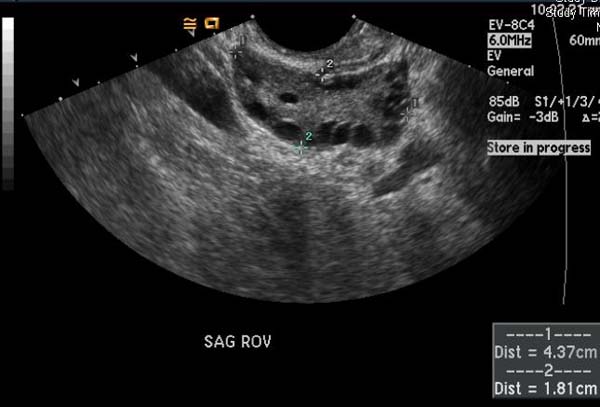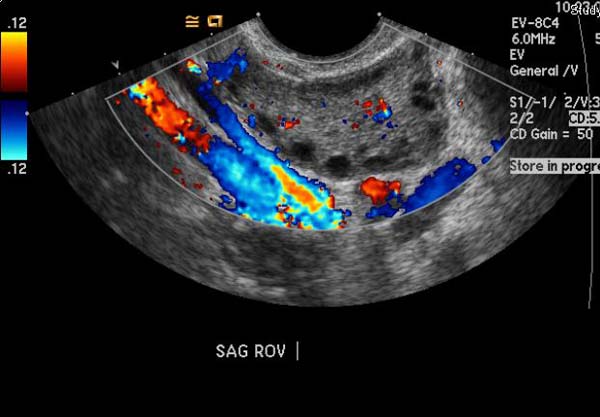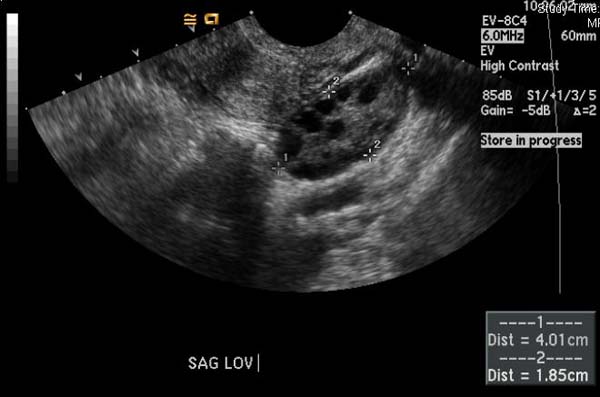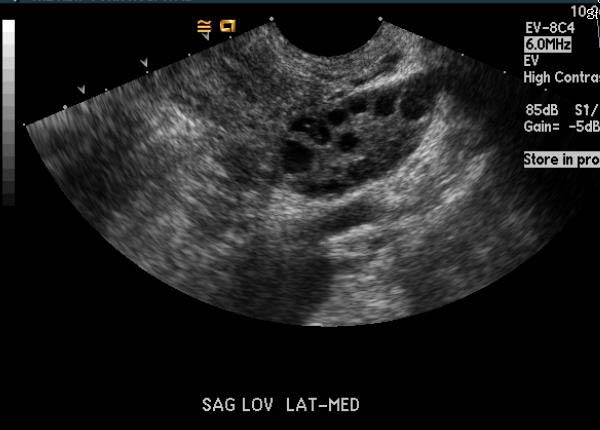Polycystic ovary syndrome ultrasound: Difference between revisions
Irfan Dotani (talk | contribs) No edit summary |
Aditya Ganti (talk | contribs) |
||
| Line 9: | Line 9: | ||
==Ultrasound== | ==Ultrasound== | ||
===Ultrasonography=== | ===Ultrasonography=== | ||
Typical ultrasonography findings in patients with PCOS are as follows: | |||
( | *Two- to 5-fold ovarian enlargement; ovarian volume >10 cm3 | ||
*Thickened stroma (tunica albuginea) | |||
*Thecal hyperplasia with an increase in stromal content | |||
*Multiple (12+) subcapsular follicles ranging from 2 to 9 mm in diameter in a state of arrested development ('pearl necklace' appearance); most are atretic and not necessarily cystic | |||
*A discrete androgen-producing tumor in the ovary may be present in 5% or fewer patients | |||
*The endometrium may be hyperplastic despite low estrogen production by the follicles; this is probably due to high estrone production from the increased circulating androgens and lack of opposition by progesterone | |||
*Clomiphene may alter results due to ovarian stimulation, resulting in multiple ovarian cysts | |||
<gallery> | <gallery> | ||
Revision as of 15:23, 3 August 2017
|
Polycystic ovary syndrome Microchapters |
|
Differentiating Polycystic ovary syndrome from other Diseases |
|---|
|
Diagnosis |
|
Treatment |
|
Case Studies |
|
Polycystic ovary syndrome ultrasound On the Web |
|
American Roentgen Ray Society Images of Polycystic ovary syndrome ultrasound |
|
Risk calculators and risk factors for Polycystic ovary syndrome ultrasound |
Editor-In-Chief: C. Michael Gibson, M.S., M.D. [1]; Associate Editor(s)-in-Chief:
Please help WikiDoc by adding content here. It's easy! Click here to learn about editing.
Overview
Ultrasound
Ultrasonography
Typical ultrasonography findings in patients with PCOS are as follows:
- Two- to 5-fold ovarian enlargement; ovarian volume >10 cm3
- Thickened stroma (tunica albuginea)
- Thecal hyperplasia with an increase in stromal content
- Multiple (12+) subcapsular follicles ranging from 2 to 9 mm in diameter in a state of arrested development ('pearl necklace' appearance); most are atretic and not necessarily cystic
- A discrete androgen-producing tumor in the ovary may be present in 5% or fewer patients
- The endometrium may be hyperplastic despite low estrogen production by the follicles; this is probably due to high estrone production from the increased circulating androgens and lack of opposition by progesterone
- Clomiphene may alter results due to ovarian stimulation, resulting in multiple ovarian cysts
-
Polycystic ovary syndrome
-
Polycystic ovary syndrome
-
Polycystic ovary syndrome
-
Polycystic ovary syndrome
Vaginal Ultrasound
A vaginal ultrasound also might be used to examine the ovaries for cysts and check out the endometrium, the lining of the uterus. The uterine lining may become thicker if your periods are not regular.



